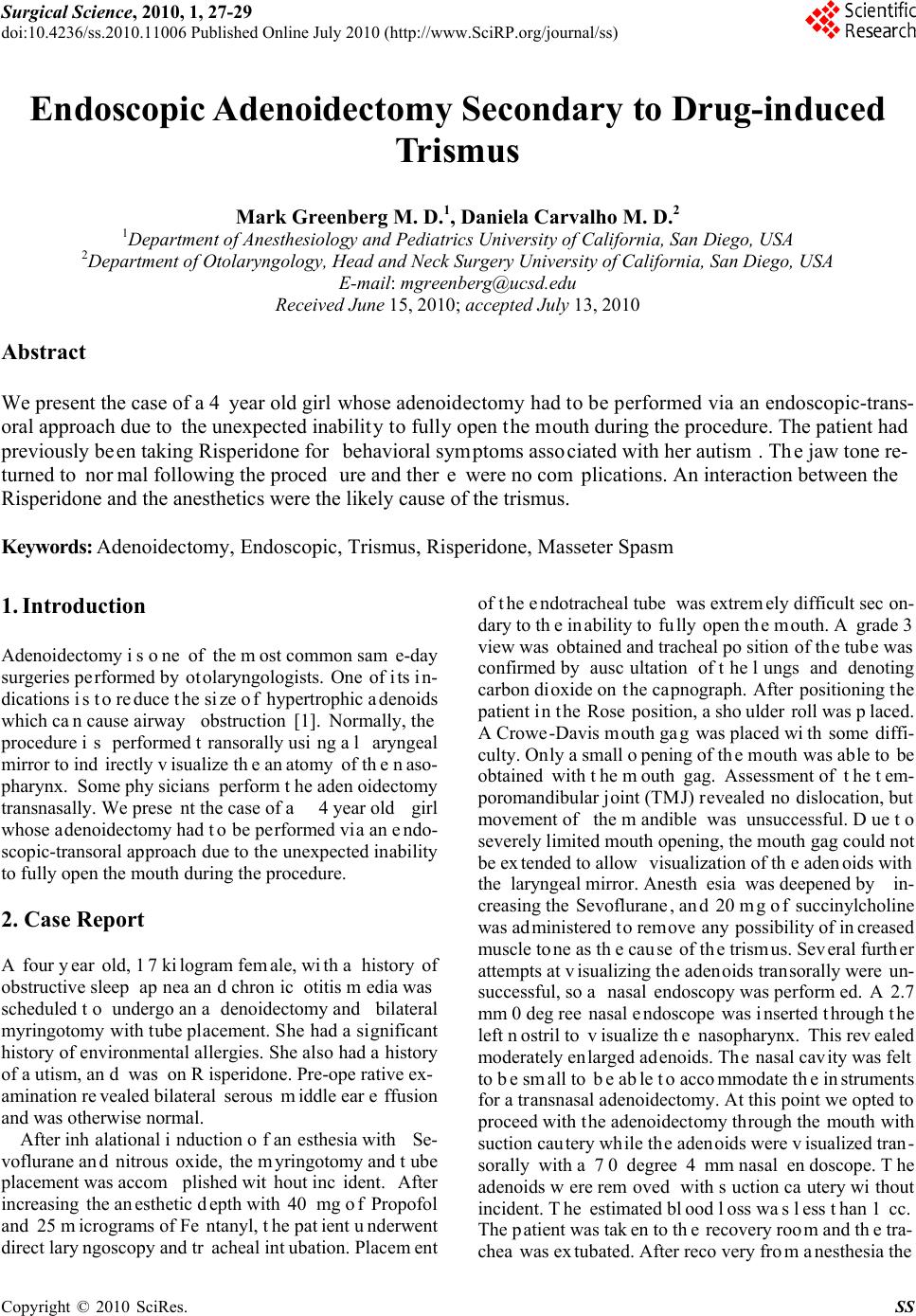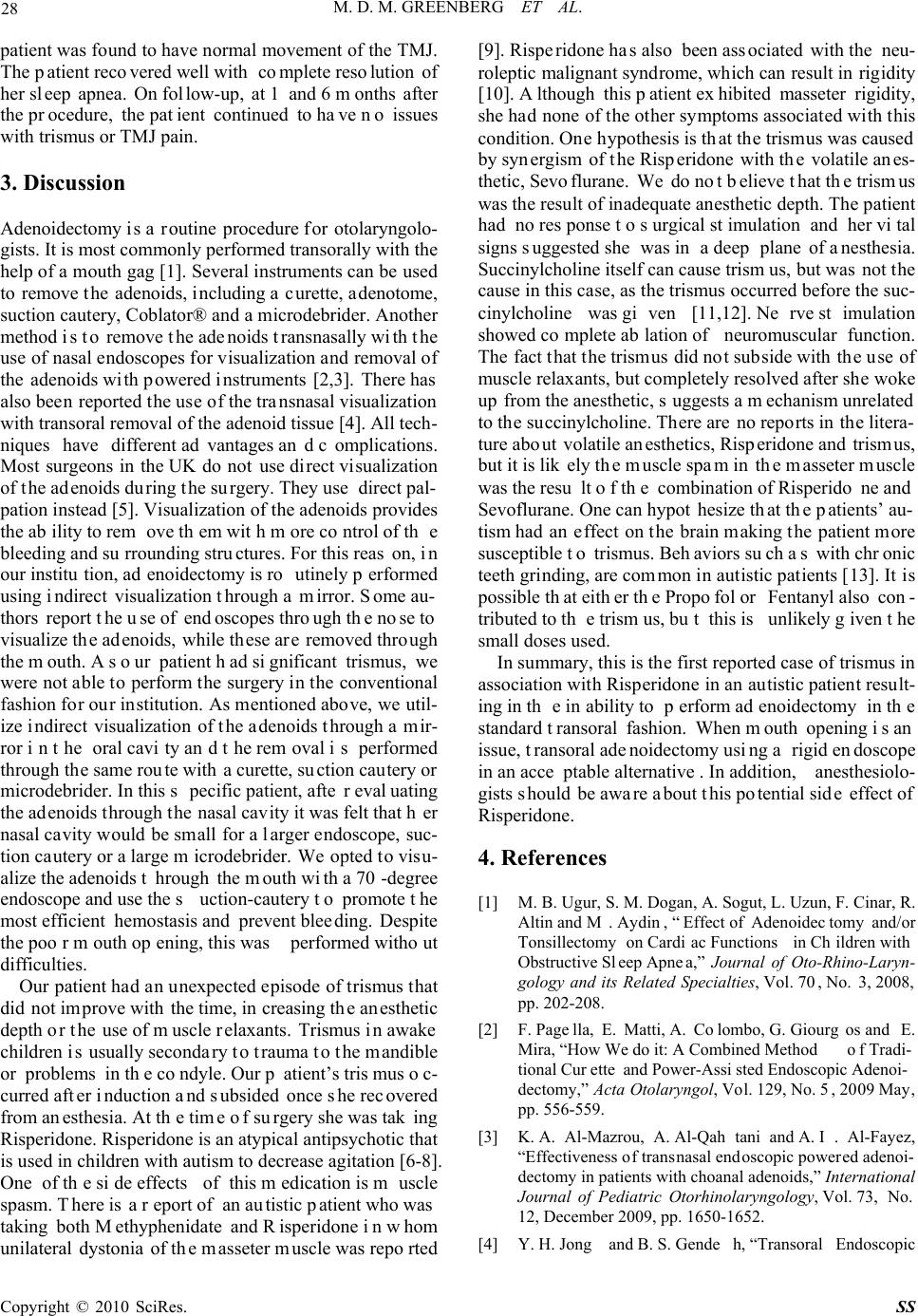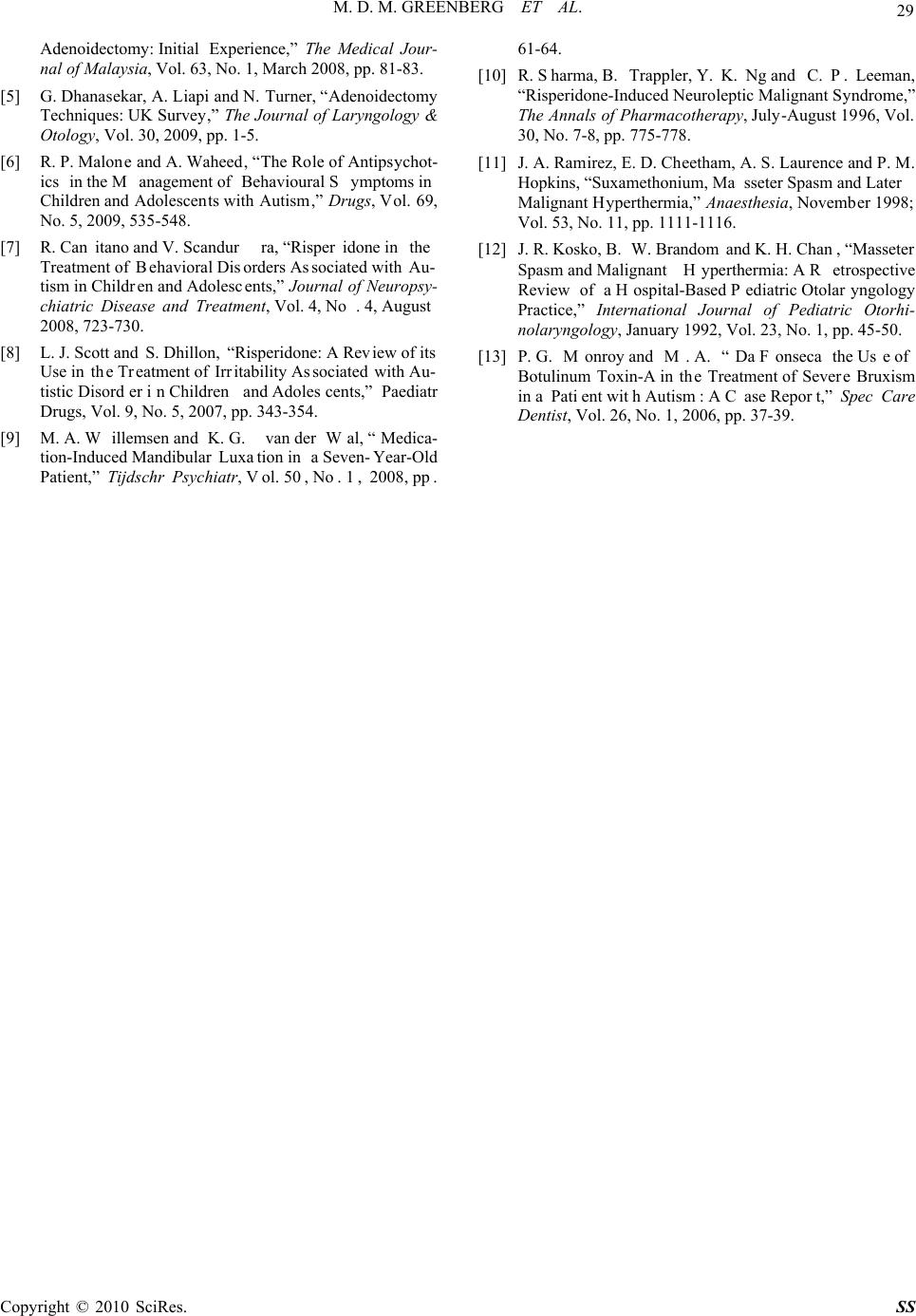Paper Menu >>
Journal Menu >>
 Surgical Science, 2010, 1, 27-29 doi:10.4236/ss.2010.11006 Published Online July 2010 (http://www.SciRP.org/journal/ss) Copyright © 2010 SciRes. SS Endoscopic Adenoidectomy Secondary to Drug-induced Trismus Mark Greenberg M. D.1, Daniela Carvalho M. D.2 1Department of Anesthesiology and Pediatrics University of California, San Diego, USA 2Department of Otolaryngology, Head and Neck Surgery University of California, San Diego, USA E-mail: mgreenberg@ucsd.edu Received June 15, 2010; accepted July 13, 2010 Abstract We present the case of a 4 year old girl whose adenoidectomy had to be performed via an endoscopic-trans- oral approach due to the unexpected inability to fully open the mouth during the procedure. The patient had previously been taking Risperidone for behavioral symptoms associated with her autism. The jaw tone re- turned to normal following the procedure and there were no complications. An interaction between the Risperidone and the anesthetics were the likely cause of the trismus. Keywords: Adenoidectomy, Endoscopic, Trismus, Risperidone, Masseter Spasm 1. Introduction Adenoidectomy is one of the most common same-day surgeries performed by otolaryngologists. One of its in- dications is to reduce the size of hypertrophic adenoids which can cause airway obstruction [1]. Normally, the procedure is performed transorally using a laryngeal mirror to indirectly visualize the anatomy of the naso- pharynx. Some physicians perform the adenoidectomy transnasally. We prese nt the case of a 4 year old girl whose adenoidectomy had to be performed via an endo- scopic-transoral approach due to the unexpected inability to fully open the mouth during the procedure. 2. Case Report A four year old, 17 kilogram female, with a history of obstructive sleep apnea and chronic otitis media was scheduled to undergo an a denoidectomy and bilateral myringotomy with tube placement. She had a significant history of environmental allergies. She also had a history of autism, and was on Risperidone. Pre-operative ex- amination revealed bilateral serous middle ear effusion and was otherwise normal. After inhalational induction of anesthesia with Se- voflurane and nitrous oxide, the myringotomy and tube placement was accomplished without incident. After increasing the anesthetic depth with 40 mg of Propofol and 25 micrograms of Fentanyl, the patient underwent direct laryngoscopy and tr acheal intubation. Placement of the endotracheal tube was extremely difficult secon- dary to the inability to fully open the mouth. A grade 3 view was obtained and tracheal position of the tube was confirmed by auscultation of the lungs and denoting carbon dioxide on the capnograph. After positioning the patient in the Rose position, a shoulder roll was placed. A Crowe-Davis mouth gag was placed with some diffi- culty. Only a small opening of the mouth was able to be obtained with the mouth gag. Assessment of the tem- poromandibular joint (TMJ) revealed no dislocation, but movement of the mandible was unsuccessful. Due to severely limited mouth opening, the mouth gag could not be extended to allow visualization of the adenoids with the laryngeal mirror. Anesth esia was deepened by in- creasing the Sevoflurane, and 20 mg of succinylcholine was administered to remove any possibility of increased muscle tone as the cause of the trismus. Several further attempts at visualizing the adenoids transorally were un- successful, so a nasal endoscopy was performed. A 2.7 mm 0 degree nasal endoscope was inserted through the left nostril to visualize the nasopharynx. This revealed moderately enlarged adenoids. The nasal cavity was felt to be small to be able to accommodate the instruments for a transnasal adenoidectomy. At this point we opted to proceed with the adenoidectomy through the mouth with suction cautery while the adenoids were visualized tran- sorally with a 70 degree 4 mm nasal endoscope. The adenoids were removed with suction cautery without incident. The estimated blood loss was less than 1 cc. The patient was taken to the recovery room and the tra- chea was extubated. After recovery from anesthesia the  28 M. D. M. GREENBERG ET AL. patient was found to have normal movement of the TMJ. The patient recovered well with complete resolution of her sleep apnea. On follow-up, at 1 and 6 months after the procedure, the patient continued to have no issues with trismus or TMJ pain. 3. Discussion Adenoidectomy is a routine procedure for otolaryngolo- gists. It is most commonly performed transorally with the help of a mouth gag [1]. Several instruments can be used to remove the adenoids, including a curette, adenotome, suction cautery, Coblator® and a microdebrider. Another method is to remove the adenoids transnasally with the use of nasal endoscopes for visualization and removal of the adenoids with powered instruments [2,3]. There has also been reported the use of the transnasal visualization with transoral removal of the adenoid tissue [4]. All tech- niques have different advantages and complications. Most surgeons in the UK do not use direct visualization of the adenoids during the surgery. They use direct pal- pation instead [5]. Visualization of the adenoids provides the ability to remove them with more control of the bleeding and surrounding structures. For this reas on, in our institution, adenoidectomy is routinely performed using indirect visualization through a mirror. Some au- thors report the use of endoscopes through the nose to visualize the adenoids, while these are removed through the mouth. As our patient had significant trismus, we were not able to perform the surgery in the conventional fashion for our institution. As mentioned above, we util- ize indirect visualization of the adenoids through a mir- ror in the oral cavity and the removal is performed through the same route with a curette, suction cautery or microdebrider. In this specific patient, after evaluating the adenoids through the nasal cavity it was felt that her nasal cavity would be small for a larger endoscope, suc- tion cautery or a large m icrodebrider. We opted to visu- alize the adenoids through the mouth with a 70-degree endoscope and use the suction-cautery to promote the most efficient hemostasis and prevent bleeding. Despite the poor mouth opening, this was performed without difficulties. Our patient had an unexpected episode of trismus that did not improve with the time, increasing the anesthetic depth or the use of muscle relaxants. Trismus in awake children is usually secondary to trauma to the mandible or problems in the condyle. Our p atient’s trismus oc- curred after induction and subsided once she recovered from anesthesia. At the time of surgery she was taking Risperidone. Risperidone is an atypical antipsychotic that is used in children with autism to decrease agitation [6-8]. One of the side effects of this medication is m uscle spasm. There is a report of an autistic patient who was taking both Methyphenidate and Risperidone in whom unilateral dystonia of the masseter muscle was reported [9]. Risperidone has also been associated with the neu- roleptic malignant syndrome, which can result in rigidity [10]. Although this patient exhibited masseter rigidity, she had none of the other symptoms associated with this condition. One hypothesis is that the trismus was caused by synergism of the Risperidone with the volatile anes- thetic, Sevoflurane. We do not believe that the trismus was the result of inadequate anesthetic depth. The patient had no response to surgical stimulation and her vital signs suggested she was in a deep plane of anesthesia. Succinylcholine itself can cause trismus, but was not the cause in this case, as the trismus occurred before the suc- cinylcholine was given [11,12]. Nerve stimulation showed complete ablation of neuromuscular function. The fact that the trismus did not subside with the use of muscle relaxants, but completely resolved after she woke up from the anesthetic, suggests a mechanism unrelated to the succinylcholine. There are no reports in the litera- ture about volatile anesthetics, Risperidone and trismus, but it is likely the muscle spam in the masseter muscle was the result of the combination of Risperido ne and Sevoflurane. One can hypot hesize that the patients’ au- tism had an effect on the brain making the patient more susceptible to trismus. Behaviors such as with chronic teeth grinding, are common in autistic patients [13]. It is possible that either the Propofol or Fentanyl also con- tributed to th e trismus, but this is unlikely given the small doses used. In summary, this is the first reported case of trismus in association with Risperidone in an autistic patient result- ing in the inability to perform adenoidectomy in the standard transoral fashion. When mouth opening is an issue, transoral adenoidectomy using a rigid endoscope in an acce ptable alternative. In addition, anesthesiolo- gists should be aware about this potential side effect of Risperidone. 4. References [1] M. B. Ugur, S. M. Dogan, A. Sogut, L. Uzun, F. Cinar, R. Altin and M. Aydin, “Effect of Adenoidectomy and/or Tonsillectomy on Cardiac Functions in Children with Obstructive Sleep Apnea,” Journal of Oto-Rhino-Laryn- gology and its Related Specialties, Vol. 70, No. 3, 2008, pp. 202-208. [2] F. Pagella, E. Matti, A. Colombo, G. Giourgos and E. Mira, “How We do it: A Combined Method of Tradi- tional Curette and Power-Assisted Endoscopic Adenoi- dectomy,” Acta Otolaryngol, Vol. 129, No. 5, 2009 May, pp. 556-559. [3] K. A. Al-Mazrou, A. Al-Qahtani and A. I . Al-Fayez, “Effectiveness of transnasal endoscopic powered adenoi- dectomy in patients with choanal adenoids,” International Journal of Pediatric Otorhinolaryngology, Vol. 73, No. 12, December 2009, pp. 1650-1652. [4] Y. H. Jong and B. S. Gendeh, “Transoral Endoscopic Copyright © 2010 SciRes. SS  M. D. M. GREENBERG ET AL. Copyright © 2010 SciRes. SS 29 Adenoidectomy: Initial Experience,” The Medical Jour- nal of Malaysia, Vol. 63, No. 1, March 2008, pp. 81-83. [5] G. Dhanasekar, A. Liapi and N. Turner, “Adenoidectomy Techniques: UK Survey,” The Journal of Laryngology & Otology, Vol. 30, 2009, pp. 1-5. [6] R. P. Malone and A. Waheed, “The Role of Antipsychot- ics in the Management of Behavioural Symptoms in Children and Adolescents with Autism,” Drugs, Vol. 69, No. 5, 2009, 535-548. [7] R. Canitano and V. Scandurra, “Risperidone in the Treatment of Behavioral Disorders Associated with Au- tism in Children and Adolescents,” Journal of Neuropsy- chiatric Disease and Treatment, Vol. 4, No. 4, August 2008, 723-730. [8] L. J. Scott and S. Dhillon, “Risperidone: A Review of its Use in the Treatment of Irritability Associated with Au- tistic Disorder in Children and Adolescents,” Paediatr Drugs, Vol. 9, No. 5, 2007, pp. 343-354. [9] M. A. Willemsen and K. G. van der Wal, “Medica- tion-Induced Mandibular Luxation in a Seven-Year-Old Patient,” Tijdschr Psychiatr, Vol. 50, No. 1, 2008, pp. 61-64. [10] R. Sharma, B. Trappler, Y. K. Ng and C. P. Leeman, “Risperidone-Induced Neuroleptic Malignant Syndrome,” The Annals of Pharmacotherapy, July-August 1996, Vol. 30, No. 7-8, pp. 775-778. [11] J. A. Ramirez, E. D. Cheetham, A. S. Laurence and P. M. Hopkins, “Suxamethonium, Ma sseter Spasm and Later Malignant Hyperthermia,” Anaesthesia, November 1998; Vol. 53, No. 11, pp. 1111-1116. [12] J. R. Kosko, B. W. Brandom and K. H. Chan, “Masseter Spasm and Malignant Hyperthermia: A Retrospective Review of a Hospital-Based Pediatric Otolaryngology Practice,” International Journal of Pediatric Otorhi- nolaryngology, January 1992, Vol. 23, No. 1, pp. 45-50. [13] P. G. Monroy and M. A. “Da Fonseca the Use of Botulinum Toxin-A in the Treatment of Severe Bruxism in a Patient with Autism: A C ase Report,” Spec Care Dentist, Vol. 26, No. 1, 2006, pp. 37-39. |

